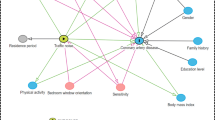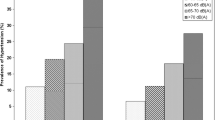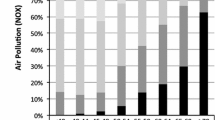Abstract
There is an established evidence that exposure to high levels of road traffic noise is associated with elevated risk of coronary heart disease (CHD). The results however have been heterogeneous and mostly inconclusive. The present investigation aimed to examine this association in adult subjects, with a secondary aim of identifying potentially vulnerable sub-populations. Similar studies have never been reported from Indian population. For exposure assessment, the time-weighted road traffic noise indicator, L den, was used as a continuous and categorical predictor. A cross-sectional study was designed, and sociodemographic and lifestyle- and health-related characteristics were recorded for 909 (533 females and 376 males) subjects aged 18–80 years. The respondents living in areas with L den < 60 dB(A) were designated as the reference group. Odds for self-reported CHD in relation to traffic noise exposure were estimated by univariate and multifactorial logistic regression with adjustments for potential confounders and effect modifiers. The adjusted odds ratio (OR) for self-reported CHD was 1.72 (95 % CI 1.36–2.19) per 5 dB(A) increase of L den (range 55–80 dB(A)). A gender-related risk difference was observed among male (OR 1.47 (1.07–2.02)) and female (OR 1.83 (1.27–2.65)) respondents. A stronger effect for subjects in the age group 55–64 years old was found, with age, residence period, body mass index, and self-reported stress being significant confounders. This study suggests epidemiological evidence that exposure to road traffic noise of L den > 65 dB(A) may be associated with occurrence of CHD in adult subjects. A trend was observed indicating increasing risk with higher exposure levels. The study results are also suggestive of higher risk of outcome among those with other chronic ailments (diabetes, pulmonary, or renal issues) and residing in the same location in excess of 15 years. Orientation of bedroom windows was identified as a significant effect modifier.


Similar content being viewed by others
References
Babisch, W. (2002). The noise/stress concept, risk assessment and research needs. Noise & Health, 4, 1–11.
Babisch, W. (2006). Transportation noise and cardiovascular risk: updated review and synthesis of epidemiological studies indicate that the evidence has increased. Noise & Health, 8, 11–29.
Babisch, W. (2011). Cardiovascular effects of noise. Noise & Health, 13, 201–204.
Babisch, W., Beule, B., & Schust, M. (2005). Traffic noise and risk of myocardial infarction. Epidemiology, 16, 33–40.
Belojevic, G., & Saric-Tanaskovic, M. (2002). Prevalence of arterial hypertension and myocardial infarction in relation to subjective ratings of traffic noise exposure. Noise & Health, 4, 33–37.
Belojevic, G., Paunovic, K., Jakovljevic, B., Stojanov, V., Ilic, J., Slepcevic, V., et al. (2011). Cardiovascular effects of environmental noise: research in Serbia. Noise & Health, 13, 217–220.
Davies, H., & Van Kamp, I. (2011). Noise and cardiovascular diseases: a review of the literature 2008-2011. Noise & Health, 14, 287–291.
Gan, W. Q., Davies, H. W., & Demers, P. A. (2011). Exposure to occupational noise and cardiovascular diseases in the United States: The National Health and Nutrition Examination Survey 1991-2004. Occupational & Environmental Medicine, 68, 183–190.
Ising, H., & Kruppa, B. (2004). Health effects caused by noise: evidence in the literature from the past 25 years. Noise & Health, 6, 5–13.
Lercher, P., Botteldooren, D., Widmann, U., Uhrner, U., & Kammeringer, E. (2011). Cardiovascular effects of environmental noise: research in Austria. Noise & Health, 13, 234–250.
Stansfeld, S., & Crombie, R. (2011). Cardiovascular effects of environmental noise: research in the United Kingdom. Noise & Health, 13, 229–233.
van Kempen, E., Kruize, H., Boshuizen, H., Ameling, C., Staatsen, B., & de Hollander, A. (2002). The association between noise exposure and blood pressure and ischemic heart disease: a meta-analysis. Environmental Health Perspectives, 110, 307–317.
Willich, S., Wegscheider, K., & Stallmann, M. (2006). Noise burden and the risk of myocardial infarction. European Heart Journal, 27, 276–282.
Yoshida, T., Kawaguchi, T., Hoshiyama, Y., Yoshida, K., & Yamamoto, K. (1997). Effects of road traffic noise on inhabitants of Tokyo. Journal of Sound & Vibration, 205, 517–522.
Acknowledgments
The authors express sincere thanks to the teacher-in-charge of B.B. College, Asansol, to Chairman WBPCB and to Chairman AMBH for granting permission to publish this article. The contributions of the household surveyor (PG Students of VU, Environment) are highly acknowledged.
Author information
Authors and Affiliations
Corresponding author
Rights and permissions
About this article
Cite this article
Banerjee, D., Das, P.P. & Foujdar, A. Association between road traffic noise and prevalence of coronary heart disease. Environ Monit Assess 186, 2885–2893 (2014). https://doi.org/10.1007/s10661-013-3587-3
Received:
Accepted:
Published:
Issue Date:
DOI: https://doi.org/10.1007/s10661-013-3587-3




